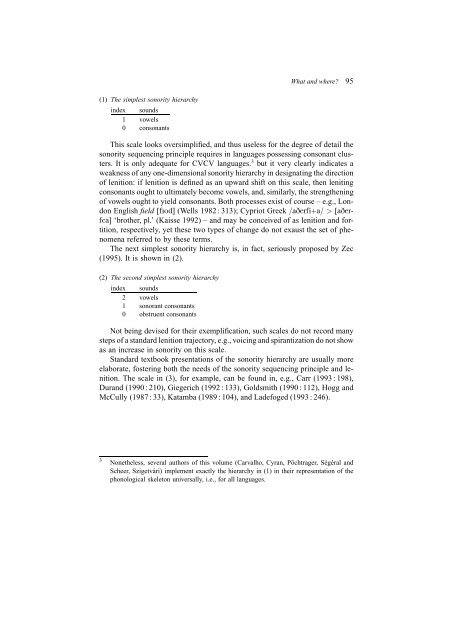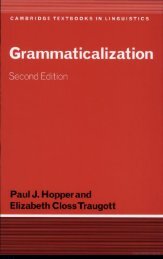What and where? Péter Szigetvári - SEAS
What and where? Péter Szigetvári - SEAS
What and where? Péter Szigetvári - SEAS
Create successful ePaper yourself
Turn your PDF publications into a flip-book with our unique Google optimized e-Paper software.
(1) The simplest sonority hierarchy<br />
index sounds<br />
1 vowels<br />
0 consonants<br />
<strong>What</strong> <strong>and</strong> <strong>where</strong>? 95<br />
This scale looks oversimplified, <strong>and</strong> thus useless for the degree of detail the<br />
sonority sequencing principle requires in languages possessing consonant clusters.<br />
It is only adequate for CVCV languages. 3 but it very clearly indicates a<br />
weakness of any one-dimensional sonority hierarchy in designating the direction<br />
of lenition: if lenition is defined as an upward shift on this scale, then leniting<br />
consonants ought to ultimately become vowels, <strong>and</strong>, similarly, the strengthening<br />
of vowels ought to yield consonants. Both processes exist of course – e.g., London<br />
English field [fIod] (Wells 1982 : 313); Cypriot Greek /aDerfi+a/ > [aDerfca]<br />
‘brother, pl.’ (Kaisse 1992) – <strong>and</strong> may be conceived of as lenition <strong>and</strong> fortition,<br />
respectively, yet these two types of change do not exaust the set of phenomena<br />
referred to by these terms.<br />
The next simplest sonority hierarchy is, in fact, seriously proposed by Zec<br />
(1995). It is shown in (2).<br />
(2) The second simplest sonority hierarchy<br />
index sounds<br />
2 vowels<br />
1 sonorant consonants<br />
0 obstruent consonants<br />
Not being devised for their exemplification, such scales do not record many<br />
steps of a st<strong>and</strong>ard lenition trajectory, e.g., voicing <strong>and</strong> spirantization do not show<br />
as an increase in sonority on this scale.<br />
St<strong>and</strong>ard textbook presentations of the sonority hierarchy are usually more<br />
elaborate, fostering both the needs of the sonority sequencing principle <strong>and</strong> lenition.<br />
The scale in (3), for example, can be found in, e.g., Carr (1993 : 198),<br />
Dur<strong>and</strong> (1990 : 210), Giegerich (1992 : 133), Goldsmith (1990 : 112), Hogg <strong>and</strong><br />
McCully (1987 : 33), Katamba (1989 : 104), <strong>and</strong> Ladefoged (1993 : 246).<br />
3 Nonetheless, several authors of this volume (Carvalho, Cyran, Pöchtrager, Ségéral <strong>and</strong><br />
Scheer, <strong>Szigetvári</strong>) implement exactly the hierarchy in (1) in their representation of the<br />
phonological skeleton universally, i.e., for all languages.
















